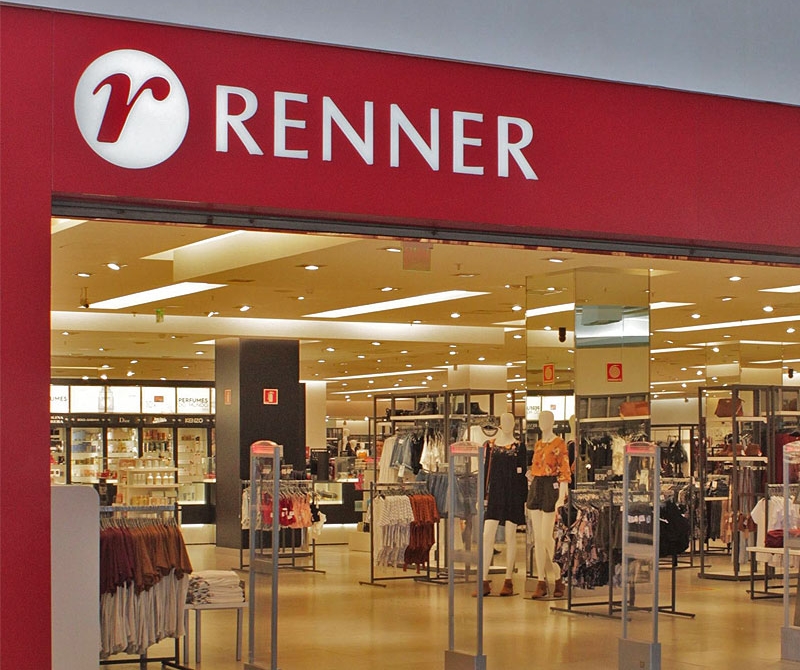Claire Swedberg
Brazilian fashion retailer Lojas Renner views radio frequency identification (RFID) technology deployment as something more than a single event aimed at improving inventory accuracy. Instead, the company of more than 400 stores is undertaking what it calls a journey with its technology partner, Sensormatic Solutions, to accomplish a series of benefits. More than 700 million products have been tagged with passive UHF RFID tags since the solution was taken live, the company reports, accomplishing four million reads daily.
The results have included a boost in inventory accuracy, an increase in sales and revenue, and a better omnichannel sales experience for customers, according to Alexandre Ribeiro, Lojas Renner’s risk director of audit, loss prevention and compliance. Since the system was deployed three years ago, he says, the company has added features that include the tracking of goods into and out of fitting rooms, enabling self-checkout sales, as well as electronic article surveillance (EAS) via the RFID tags applied to each product. The retailer’s journey will continue by bringing supply chain visibility and visibility benefits to its suppliers.
Sensormatic Solutions, based in Florida, acted as Renner’s technology partner throughout the deployment, providing its TrueVUE inventory-management software platform, along with hardware and integration. The solution was an RFID Journal Award finalist in the category of Best Retail RFID or IoT Implementation in 2022, and again this year (see Finalists Announced for 16th Annual RFID Journal Awards, Finalists Announced for 17th Annual RFID Journal Awards, RFID Journal Award Finalist Session: Lojas Renner Uses RFID to Enable Omnichannel Experience and RFID Journal LIVE! and the RFID Industry Are Bouncing Back).

Renner is the largest fashion and department store in Brazil. The company sells fashion for men, women and children, as well as accessories and watches, at its 435 stores across that country, and in Uruguay and Argentina. More than a decade ago, the retailer began investigating the use of RFID technology to address its highly challenging inventory management. The stores each receive up to 20,000 new items daily, which traditionally required employees to physically check products when they arrived, then manually track when they were put away in the back room or stocked on the sales floor.
Replenishment of goods sold was a manual process that relied on sales personnel to identify products that needed replacement, along with the required quantity of each model, size and color. To conduct store-wide inventory counts, Renner relied on a third-party company that sent multiple workers to count goods over a span of eight to ten hours. That count was conducted only once a year, Ribeiro notes.
“The main problem we needed to solve,” Ribeiro says, “was the customer experience throughout their [shopping] journey,” to ensure not only product availability, but also an easy payment experience and self-service options. Renner researched the technology and its providers for years. “We studied and evaluated several companies that acted as integrators, suppliers and manufacturers of hardware, software and RFID tags. At the end of the research and benchmarking stage, it was possible to conclude that, until then, no other retailer in the world had implemented RFID in the scale, breadth of process and speed that Renner was aiming to do.”
The retailer chose to work with Sensormatic Solutions. “The relationship has been going a long time, in terms of the journey that we went on together,” says John Gregg, Sensormatic’s VP and general manager for Latin America. The technology company, he recalls, needed to demonstrate to Renner that managing an RFID deployment was best sourced to a single holistic technology provider. The partners then worked together to test the appropriate tags and readers. “We have a wide range of products besides clothes and shoes,” Ribeiro says, “such as makeup, fragrances and skincare products.”
These products can be composed of liquid, with metallized packaging, both of which can impact RFID transmission. Therefore, the team performed tests for adhesive RFID labels that would ensure reading effectiveness and be visually acceptable. They also had to select tags that could be sewn into garments, as opposed to being attached to disposable hang tags. Renner then executed a three-month test at five stores, during which it labeled 5 percent of its products and tested the RFID functionality for receiving, inventory counting and replenishment.
All Renner suppliers are now applying tags before sending items to the retailer. To ensure suppliers have access to the tags they need, Sensormatic provides an RFID tag-encoding service that provides all of the tags used in Brazil, while also managing its relationships with suppliers in foreign locations for Asian manufacturers. In this way, Sensormatic acquires and supplies the necessary 200 million tags used by the retailer annually. “All of those tags come through our RFID tag-encoding service,” Gregg explains, “and are delivered into their manufacturing locations either internationally or in Brazil.”

With the RFID solution in place for the past three years, every piece of merchandise comes with a tag sewn in or affixed to it. The unique ID number encoded on each tag is linked to the corresponding product details in the TrueVUE software. Store associates use Bluebird RFR900 RFID handheld readers attached to EF500 Android-based mobile computers to read items’ tags as they are received. The tag reads update the store’s inventory data to indicate those products are onsite.
When employees move the products onto the sales floor, they again read the tags using the handheld reader, thereby updating the status of the items as being on display. Each store has at least one fixed reader in the fitting rooms, with antennas mounted at the entrance. As shoppers bring clothing into a fitting room, the tag IDs are captured, updating the software to indicate what is being tried on. As the customers leave that area, those tags are read again. The collected data provides sales analytics for Renner. “We can match this data against actual purchases,” Ribeiro says, to identify how well specific garments are performing when it comes to sales after a fitting.
There are three options for customer purchasing, One involves a mobile app, by which a customer would scan the barcode printed on a product label or hangtag with a smartphone, then complete the sales payment with a credit card or other payment information, such as Apple Pay. The shopper would then take the product to a desk, where the RFID tag would be read. Another option would be to proceed to a sales associate to purchase goods at the point of sale (POS). In such a scenario, an Acura fixed desktop reader, supplied by Sensormatic, is installed at the sales counter to read the tags of all products being bought.
The data is displayed for the customer and the employee, and after the transaction is approved and completed, the inventory data is updated in the software. The reader deactivates all the tags so that those products can be removed from the store. Renner and Sensormatic created a unique solution for managing tags without disabling them. As each tag is read, part of its EPC number is changed, with a new code added to the selected field to prevent an alarm by ignoring that tag. If a customer returns with the product or exchanges it, the reader can restore the tag’s original EPC code, after which the product will again be part of the store’s stock.
The third option is a self-checkout kiosk with a bin, in which a customer can place goods being purchased. They can use the touch screen to conduct the purchase, while the reader built into the bin captures tag IDs, identifies what is being purchased and deactivates those tags. The self-checkout system has been so popular, Ribeiro says, that it accounts for approximately a third of all sales at physical stores. Fixed readers installed at each doorway conduct final tag reads as goods are removed from stores. If any tags have been deactivated, they will not be read, but as long as they have not been deactivated, the EAS system will identify the products being removed and sound an alert.
Altogether, Renner has purchased more than 5,000 mobile handhelds and fixed readers, distributed among more than 400 stores, and the company now has more than 3,500 POS sites using fixed readers. In addition, Renner has installed more than 500 self-checkout kiosks at its main stores, and it is now in the process of expanding the technology to additional locations. The company has installed more than 5,000 alarm pedestals at its stores as well.
All tags are applied at the point of manufacture. Lojas Renner is providing its Brazilian suppliers with RFID labels from Sensormatic, while other international suppliers use RFID tags from Avery Dennison Smartrac. Since the system was deployed, Renner’s staff members have been conducting inventory counts at least monthly, ensuring customers have access to greater item availability.
That enables more accurate omnichannel sales, the company indicates, because the software can place a sales order based on the inventory availability at a store near the online customer. Going forward, Ribeiro says, “Our research team is constantly evaluating improvements.” The company, for instance, has adjusted the size of the servers managing the data, to accommodate the vast number of tags and read events.
Additionally, Renner has adapted processes such as limiting the number of stores that can simultaneously conduct cycle counts. “In the current scenario,” he states, “we allow 100 stores to perform inventory counting simultaneously, reaching an average of 15 million pieces read at the same time.” The retailer has also conducted training sessions, both live and online, to adjust store operations to the newly implemented RFID processes.
The TrueVUE solution can be integrated with existing systems, Sensormatic notes, such as replenishment and planogram applications developed internally. The technology can also be integrated with Oracle’s enterprise resource planning system, for accounting stock and tax management. The information generated in TrueVUE during store operations is accessed online by TrueVUE Reporting, Ribeiro says, “so we can have access to several types of reports.” In the loss-prevention area alone, he adds, the company has generated 33 reports and the system has been accessed 16 thousand times monthly.
According to Renner, out-of-stock events have been reduced by 87 percent since the RFID system was taken live, ensuring customers can find the products they seek. Inventory accuracy has been increased by 64 percent, and Renner has achieved a sales increase of 1.8 percent at its RFID-enabled stores, while it projects an increase in sales of up to 3 percent in the coming years. “Our customers were the ones who benefited the most,” Ribeiro states, “as they spent less time in lines and have the possibility to make the purchase and the alarm deactivation at any point in the store.”



















